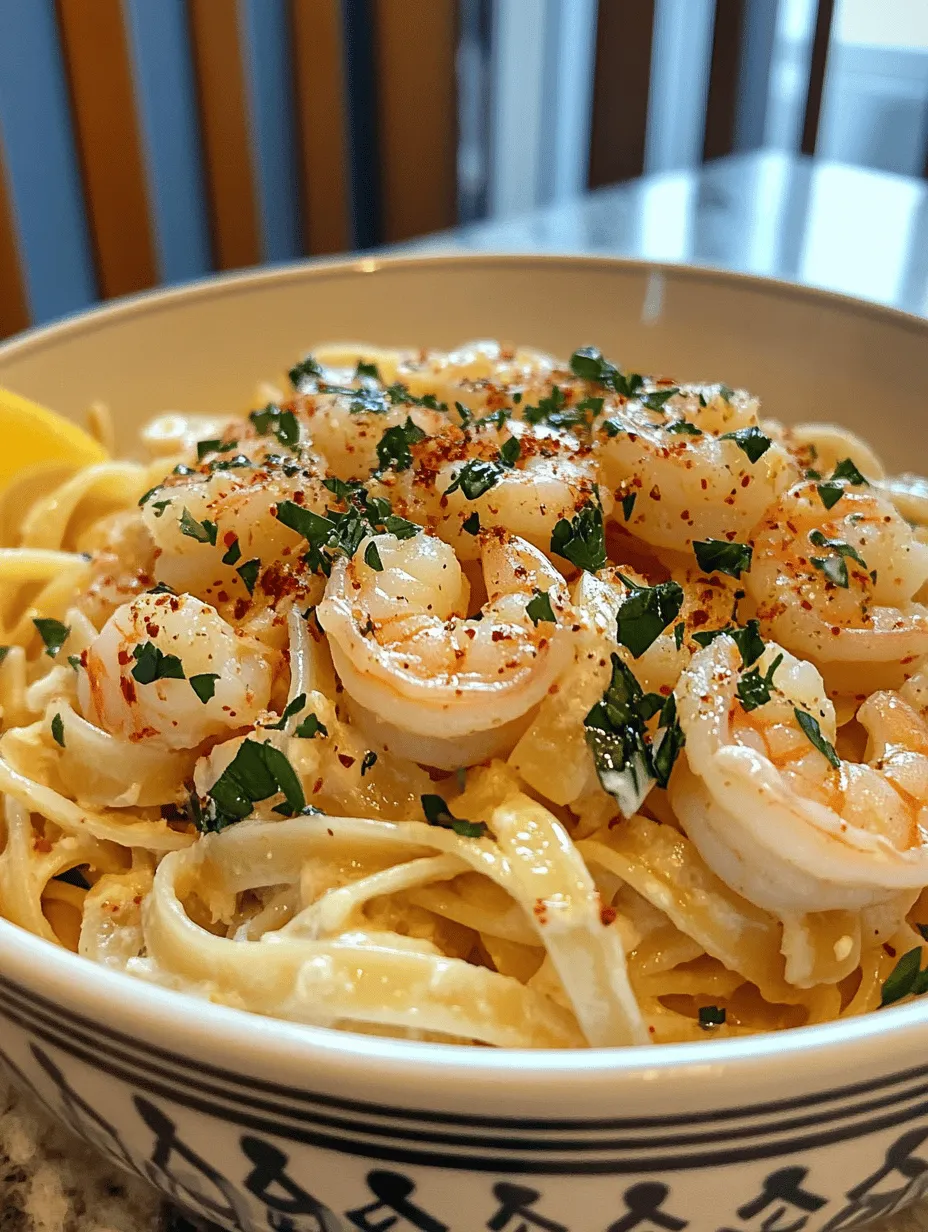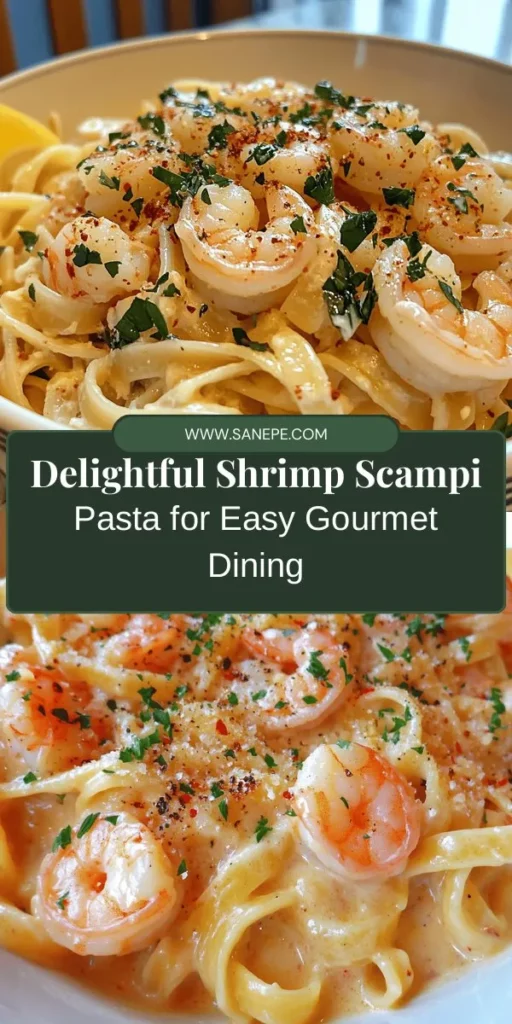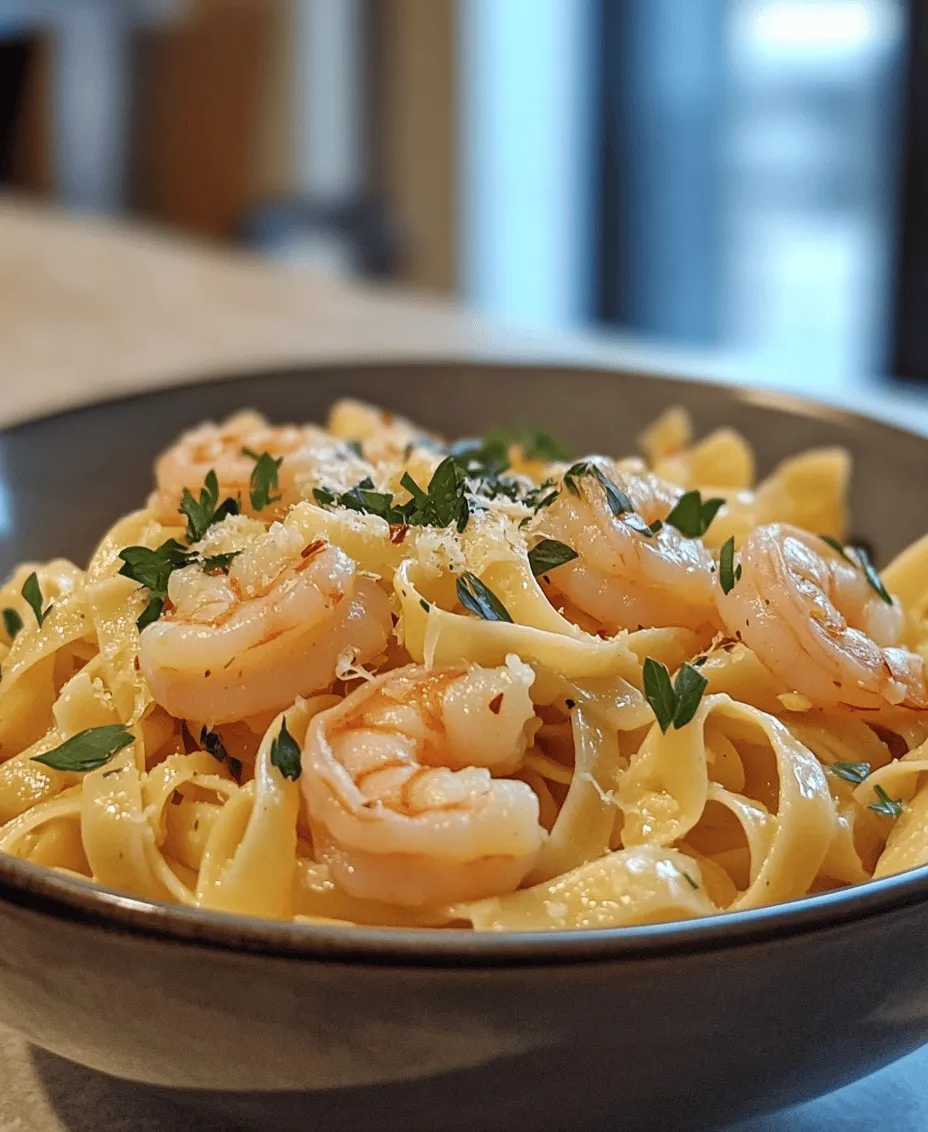Shrimp Scampi Pasta is more than just a dish; it’s a symphony of flavors that transports you to a seaside restaurant with every bite. This delightful recipe perfectly balances the richness of butter, the zestiness of lemon, and the succulence of shrimp, creating a culinary experience that is both comforting and sophisticated. As you embark on this delicious journey, you’ll discover that this dish can be prepared in under 30 minutes, making it ideal for both weeknight dinners and special occasions. Whether you are cooking for family, friends, or a romantic dinner for two, Shrimp Scampi Pasta is sure to impress anyone at your table.
The origins of Shrimp Scampi can be traced back to Italian-American cuisine, where it has become a beloved staple in many households. Traditionally, “scampi” refers to a type of shellfish, specifically the langoustine, but in the United States, the term has come to represent a preparation style that involves sautéing shrimp in garlic, butter, and white wine. This recipe takes that classic preparation and elevates it with the addition of pasta, transforming it into a hearty and satisfying meal.
Understanding the Ingredients
To achieve the perfect Shrimp Scampi Pasta, it is crucial to understand the essential components that make up this delightful dish. Each ingredient plays a significant role in creating a harmonious balance of flavors and textures.
The Pasta Base
When it comes to selecting the pasta for your scampi dish, linguine or spaghetti are the ideal choices. These long, thin noodles have a wonderful ability to hold onto sauces, ensuring that every bite is infused with flavor. Linguine, with its flat shape, offers a slight chewiness that pairs beautifully with the buttery sauce, while spaghetti provides a classic, familiar texture. Whichever you choose, make sure to cook it to al dente perfection—this means the pasta should be firm to the bite while still tender. This texture not only enhances the overall eating experience but also helps the pasta maintain its structure when combined with the sauce.
Shrimp Selection
The star of the dish is, of course, the shrimp. When sourcing shrimp, you have the option of using fresh or frozen varieties. Fresh shrimp can be a delightful treat, but frozen shrimp is often just as good and more convenient. Look for shrimp that are firm and have a slight sheen, indicating freshness. Pay attention to size as well; larger shrimp, such as U/10 or 10/20 count, are ideal for this dish as they provide a satisfying bite and are less likely to overcook. If using frozen shrimp, be sure to thaw them completely before cooking to ensure even cooking and avoid a watery sauce.
Flavor Enhancers
Garlic, olive oil, and red pepper flakes are the flavor enhancers that form the aromatic foundation of Shrimp Scampi Pasta. Garlic is essential for imparting a deep, savory flavor that complements the sweetness of the shrimp. Use fresh garlic for the best results, as it releases essential oils that elevate the dish. Extra virgin olive oil is preferred for sautéing due to its rich flavor and health benefits. Lastly, red pepper flakes add a touch of heat, balancing the richness of the butter and the acidity of the wine and lemon juice.
Wine and Citrus
Dry white wine and lemon juice are pivotal in creating a balanced sauce for Shrimp Scampi Pasta. The wine not only adds depth and complexity to the flavor profile, but it also helps to deglaze the pan, lifting the browned bits from the bottom and incorporating them into the sauce. Choose a wine that you enjoy drinking, as its flavors will be concentrated in the dish. Lemon juice brightens the sauce, cutting through the richness of the butter and enhancing the freshness of the shrimp. A squeeze of lemon just before serving will elevate the dish even further.
Herbs and Garnishes
To finish off your Shrimp Scampi Pasta, fresh parsley and Parmesan cheese are essential garnishes that enhance flavor and presentation. Chopped fresh parsley adds a pop of color and a hint of freshness that contrasts beautifully with the rich sauce. Parmesan cheese, whether grated or shaved, provides a nutty richness that rounds out the dish. When serving, consider a light sprinkle of both for an appealing visual and a burst of flavor.
Step-by-Step Cooking Instructions
Now that you understand the key ingredients that make up Shrimp Scampi Pasta, it’s time to dive into the cooking process. Providing clear, step-by-step instructions will ensure that you feel confident as you create this delicious dish.
Cooking the Pasta
1. Boil Water: Start by bringing a large pot of salted water to a rolling boil. The salt not only flavors the pasta but also helps to enhance its natural taste.
2. Add Pasta: Once the water is boiling, add your linguine or spaghetti. Stir occasionally to prevent sticking. Cook according to the package instructions until al dente, usually about 8-10 minutes.
3. Reserve Pasta Water: Before draining the pasta, be sure to reserve about a cup of the starchy pasta water. This water will help to thicken and bind your sauce, ensuring it clings beautifully to the noodles.
4. Drain and Set Aside: Drain the pasta in a colander and set it aside while you prepare the sauce.
Sautéing the Shrimp
1. Heat the Pan: In a large skillet, heat a generous drizzle of olive oil over medium-high heat. Allow it to become hot but not smoking.
2. Add Garlic: Once the oil is hot, add minced garlic to the skillet. Sauté for about 30 seconds, stirring constantly to prevent burning. You want the garlic to become fragrant and golden.
3. Cook the Shrimp: Add the shrimp to the skillet in a single layer. Season them with salt, pepper, and red pepper flakes. Sauté the shrimp for about 2-3 minutes on one side until they turn pink and opaque. Flip them to cook the other side for an additional 2 minutes, ensuring they are cooked through but not overcooked.
Creating the Sauce
1. Deglaze the Skillet: Once the shrimp are cooked, carefully pour in about half a cup of dry white wine. Use a wooden spoon to scrape up any browned bits from the bottom of the skillet—this is where the flavor lies.
2. Add Lemon Juice: Squeeze fresh lemon juice into the skillet, adding brightness to the sauce. Allow the mixture to simmer for a couple of minutes, reducing slightly to concentrate the flavors.
3. Incorporate Butter: Stir in a generous amount of unsalted butter, allowing it to melt and create a rich, silky sauce. If the sauce seems too thick, add a little reserved pasta water to achieve the desired consistency.
Combining the Ingredients
1. Toss in the Pasta: Add the cooked pasta directly into the skillet with the shrimp and sauce. Toss gently to combine, ensuring that every strand of pasta is coated in that luscious sauce.
2. Adjust Seasoning: Taste the dish and adjust the seasoning as necessary. You can add more salt, pepper, or red pepper flakes to suit your preference.
Final Touches
1. Garnish: Remove the skillet from the heat and sprinkle chopped fresh parsley and grated Parmesan cheese over the pasta. Toss lightly to combine.
2. Serve: Serve the Shrimp Scampi Pasta immediately, garnished with additional parsley and Parmesan cheese. A few lemon wedges on the side will allow your guests to add an extra squeeze of brightness to their plates.
With these detailed steps and careful attention to each ingredient, you’re well on your way to creating a mouthwatering Shrimp Scampi Pasta that will delight your senses and impress your guests. Enjoy the vibrant flavors and rich textures as you savor each bite of this culinary adventure!
Shrimp Scampi Pasta Delight: A Culinary Adventure!
Health Benefits of Key Ingredients
Shrimp as a Protein Source
Shrimp is not just a culinary delight; it is also a powerhouse of nutrition. A standard serving of shrimp (approximately 3 ounces) contains around 20 grams of protein while being remarkably low in calories—only about 84 calories. This makes shrimp an excellent option for those looking to build muscle or maintain a healthy weight. Additionally, shrimp is low in saturated fats and cholesterol, making it a heart-healthy protein choice. It is also rich in essential nutrients such as iodine, selenium, and vitamin B12, all of which play vital roles in metabolic processes, immune function, and overall cellular health.
Health Benefits of Olive Oil
Olive oil is a staple in Mediterranean cuisine, and for good reason. Renowned for its heart-healthy monounsaturated fats, it helps reduce bad cholesterol levels while increasing good cholesterol. This contributes to better cardiovascular health. Olive oil is also loaded with antioxidants, particularly vitamin E, which protects the body from oxidative stress and inflammation. The benefits extend beyond heart health, as it has been linked to improved brain function and a lowered risk of chronic diseases. When used in the Shrimp Scampi Pasta Delight, olive oil not only enhances flavor but also boosts the dish’s nutritional profile.
The Role of Garlic
Garlic is often hailed as a superfood due to its numerous health benefits. This aromatic ingredient is rich in antioxidants and contains compounds like allicin, which have been shown to reduce blood pressure and cholesterol levels. Garlic is also known for its immune-boosting properties, making it a great addition to any dish, especially during cold and flu season. The anti-inflammatory properties of garlic contribute to overall health and well-being. In the context of the Shrimp Scampi Pasta, garlic’s robust flavor elevates the dish while providing these impressive health benefits.
Herbs and Citrus
Fresh herbs such as parsley and basil not only add vibrant color to your dish but also pack a nutritional punch. They are rich in vitamins A, C, and K, which are essential for skin health, immune function, and bone health. Citrus, particularly lemon juice and zest, adds brightness and acidity to balance the richness of the dish. Additionally, citrus fruits are high in vitamin C, which supports the immune system and aids in digestion. The combination of fresh herbs and citrus not only enhances the flavor of the Shrimp Scampi Pasta Delight but also contributes to its health benefits.
Variations and Substitutions
Pasta Alternatives
While traditional pasta is delicious, there are plenty of alternatives for those seeking gluten-free or healthier options. Zucchini noodles (zoodles) or spaghetti squash are fantastic low-carb options that provide a similar texture to pasta while being much lighter. If you prefer whole grain pasta, options like whole wheat or brown rice pasta are great choices, offering more fiber and nutrients than regular pasta. These alternatives can make the dish more versatile and cater to different dietary preferences.
Vegetarian Adaptations
For those who prefer a vegetarian option, transforming the Shrimp Scampi Pasta into a vegetable-based dish is entirely possible. Seasonal vegetables such as bell peppers, asparagus, or spinach can replace shrimp, sautéed in the same olive oil and garlic to absorb the rich flavors. Additionally, plant-based shrimp alternatives are becoming increasingly popular and can be used to retain the original concept of the dish without compromising on taste. This adaptation allows for creativity in the kitchen while ensuring that everyone at the table can enjoy the meal.
Spice Adjustments
The beauty of the Shrimp Scampi Pasta lies in its flexibility. If you enjoy a little heat, consider adding red pepper flakes or diced jalapeños to the garlic and olive oil mixture for a spicy kick. Alternatively, for those who prefer a milder flavor, you can tone down the spice and enhance the dish with sun-dried tomatoes or capers, which add tanginess and depth. Experimenting with different spices and ingredients can help you create a unique version of this classic dish that resonates with your taste preferences.
Serving Suggestions
Pairing Wines
To elevate your dining experience, consider pairing the Shrimp Scampi Pasta Delight with the right wine. A crisp white wine, such as Pinot Grigio or Sauvignon Blanc, complements the seafood beautifully, enhancing the flavors of the shrimp and herbs. If you prefer a rosé, choose one that is dry and refreshing to balance the richness of the dish. The key is to select a wine with enough acidity to cut through the flavors and provide a harmonious pairing.
Ideal Sides
To create a well-rounded meal, serve the Shrimp Scampi Pasta with a simple green salad dressed with lemon vinaigrette. The freshness of the salad will complement the richness of the pasta. Garlic bread is another ideal side dish, allowing you to soak up any leftover sauce while adding an aromatic touch to your meal. For a heartier option, consider roasted vegetables, which add additional nutrients and flavor.
Presentation Ideas
Presentation plays an essential role in the dining experience. When plating the Shrimp Scampi Pasta, consider using a large pasta bowl or individual plates to showcase the vibrant colors of the dish. Garnish with freshly chopped parsley and a sprinkle of grated Parmesan cheese for an added touch of elegance. A lemon wedge on the side not only enhances the presentation but also invites guests to add a dash of citrus for an extra flavor boost. Thoughtful presentation can elevate your meal from ordinary to extraordinary.
Conclusion
Shrimp Scampi Pasta Delight is not just a meal; it’s a culinary adventure that combines fresh ingredients and vibrant flavors. With its quick preparation time and robust taste, this dish is perfect for any occasion, whether it’s a casual family dinner or an intimate date night. By understanding the health benefits of the ingredients, mastering the cooking techniques, and exploring variations, anyone can create a dish that is both delicious and satisfying. Enjoy the culinary adventure that this shrimp scampi pasta brings to your table, and savor every bite of this delightful experience.



